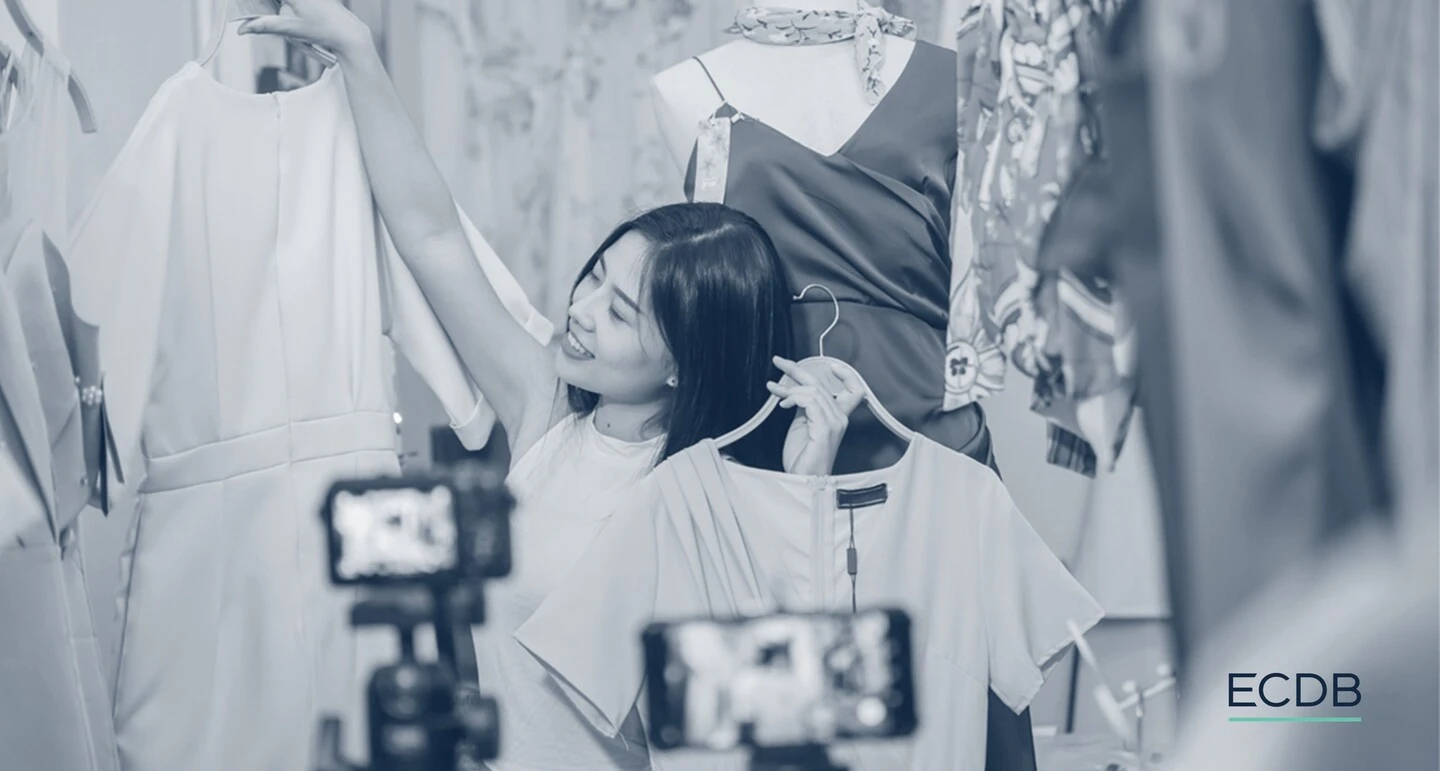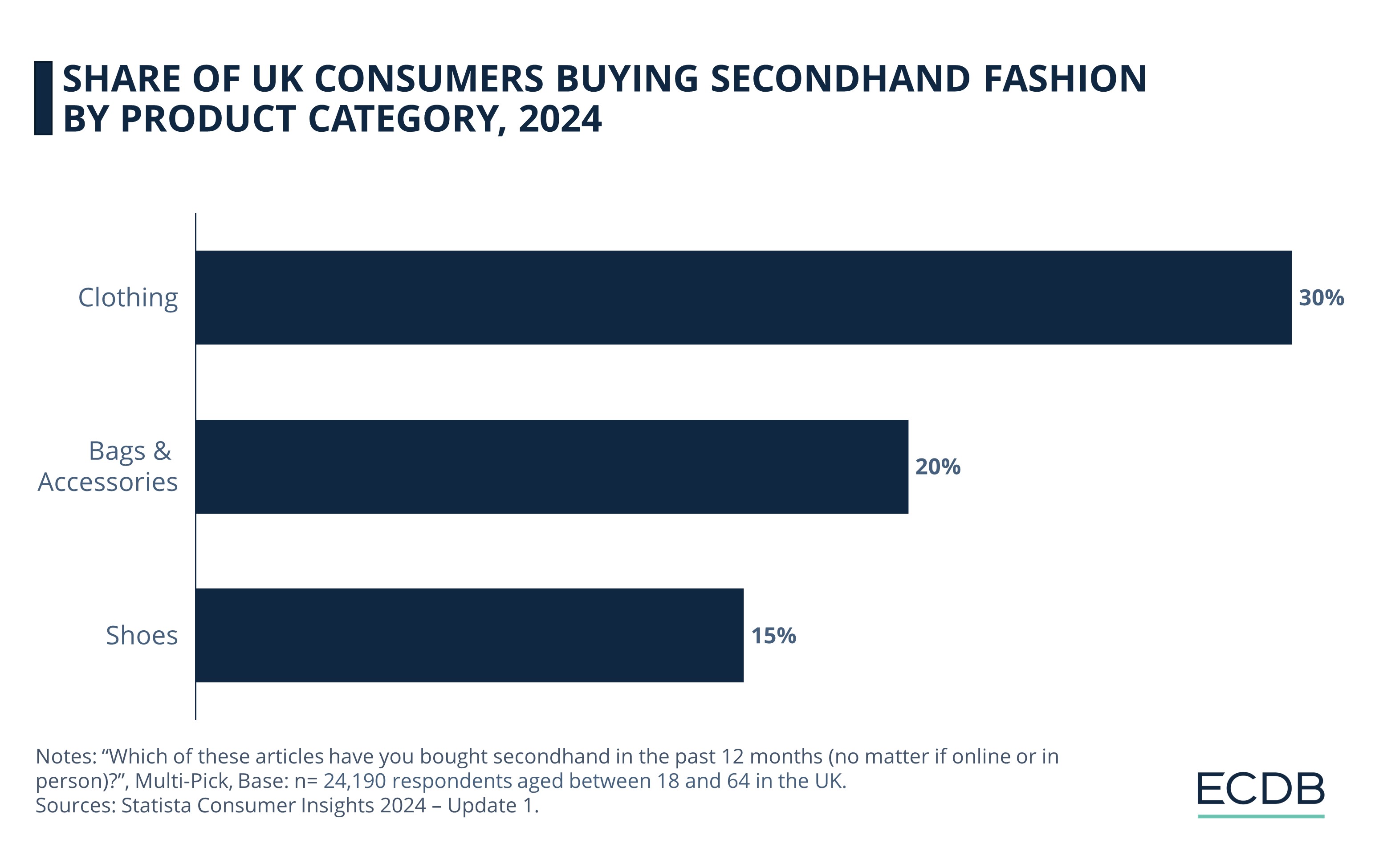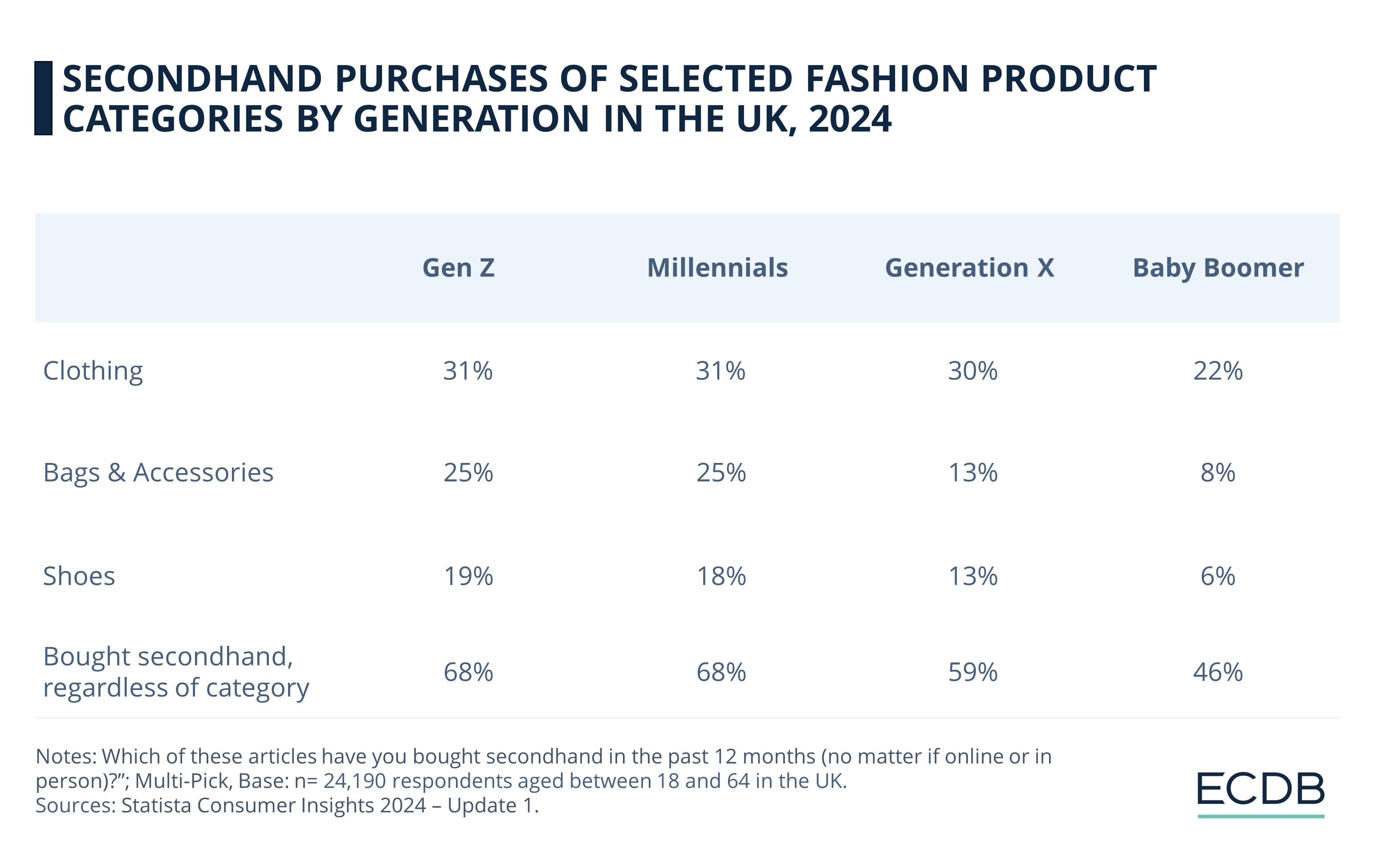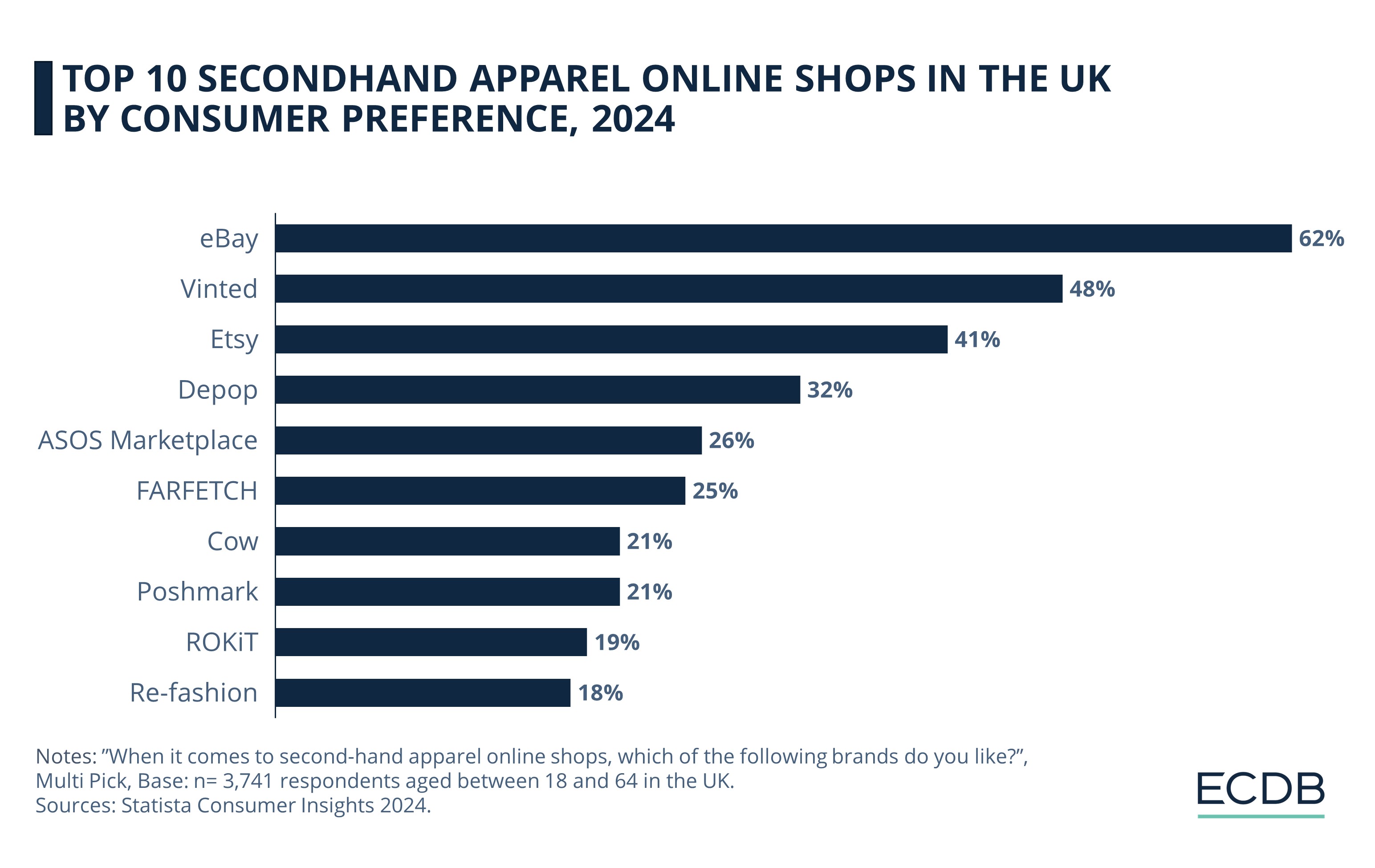ReCommerce Trend
Fashion ReCommerce in the UK: Top Categories, Generational Attitudes, Leading Shops
ReCommerce is growing, with customers now buying a variety of pre-owned fashion products online. Discover the leading fashion categories for reCommerce, generational preferences, and top ten reCommerce apparel shops in the UK.
Article by Nadine Koutsou-Wehling | May 13, 2024
Fashion ReCommerce in the UK: Key Insights
Top Category: Among all fashion subcategories in the UK, Clothing is the most popular to be bought secondhand: 30% of respondents bought a used clothing item in the past year.
Generational Preferences: The youngest shoppers – Gen Z and Millennials – are most active in buying secondhand products in all categories, with 68% of them having engaged in secondhand shopping lately.
Most Preferred Secondhand Apparel Shops: At 62%, eBay has the highest level of platform preference among UK’s secondhand shoppers in 2024. Vinted and Etsy also rank in the top three.
ReCommerce – or reverse commerce – refers to the sale and purchase of secondhand products. This rising trend is mainly driven by eco-conscious consumers who prefer pre-owned goods at affordable prices and less damage to the environment.
The shift towards reCommerce is visible in the UK among all generations of shoppers, particularly in fashion.
Learn which categories of fashion products are bought secondhand the most, attitudes by generation, and the most popular shops to buy secondhand clothing in the UK.
Top Fashion Category Bought Secondhand Is Clothing
In Statista’s 2024 Consumer Insights, UK online shoppers were asked if they had bought secondhand products over the last year. Although the numbers are not limited to online purchases, we can use these responses to assess consumer willingness to buy pre-owned products.

Secondhand purchases are not uncommon in the UK. Clothing is popular among UK secondhand shoppers, with 30% of consumers stating that they bought a used piece of clothing in the last 12 months.
The second most-bought fashion category for secondhand purchases is Bags & Accessories, at 20%. The least popular is Shoes, with 15%.
Looking at secondhand purchases in general, regardless of product category, an even higher percentage of UK users say they have recently purchased a secondhand item: 63% of UK online shoppers say they've bought secondhand in the past year, compared to 37% who haven't.
But what impact does age have on consumers' willingness to buy pre-owned products?
Secondhand Fashion Is Most Attractive to Younger Users
Age is negatively correlated with buying secondhand, which means that younger shoppers are more likely to have bought a pre-owned item recently.

This is consistent with previous reports by other publications. In general, 68% of Gen Z as well as Millennial respondents said they have bought secondhand in the last year.
Amongst older shoppers, more Generation X (59%) bought secondhand in the past year than Baby Boomers who, at 46%, are the least inclined amongst all generational cohorts to buy secondhand. But even at this rate, nearly half of Baby Boomers purchased secondhand products, which is a significant share.
In comparison, younger consumers are more inclined to purchase pre-owned goods. In particular, consumers aged between 30 and 39 report the highest level of secondhand purchases in 2024, with 70% of respondents saying they bought secondhand in the past year.
Although these figures do not specify whether products were purchased online or analog, they show us that there is a high willingness to buy used Fashion products among UK consumers, regardless of age.
Secondhand Clothes Most Attractive to All Generations
Looking at specific fashion product categories, we see that clothing is not only the top choice to buy pre-owned but is also the secondhand category with the least variation across generations.
31% of Gen Z and Millennial online shoppers said they have bought secondhand clothing in the past year, followed by 30% of Gen X and 22% of Baby Boomers.
Bags & Accessories are most popular among Gen Z shoppers (25%), while secondhand Shoes were bought by Gen Z at a lower rate of 19%. For Millennials, the category wise preference is comparable to Gen Z.
Older Users Are Less Interested in Secondhand Accessories or Shoes
Categories other than Clothing are of much less interest to Gen X and Baby Boomer secondhand shoppers.
13% of Gen X shoppers have bought either used Bags & Accessories or Shoes, while these rates are even lower for Baby Boomers, at 8% and 6% respectively.
The reasons for this disparity between the younger and older cohorts are thought to lie in changing attitudes towards fashion and the textile industry. While fast fashion has contributed to increasing amounts of waste in landfills around the world, affordability is also a major concern.
On the one hand, young users are the most likely to buy from the likes of Shein and Boohoo, but there is a reverse trend where young users are buying secondhand to combine sustainability with lower costs.
A Changing Paradigm: Leading Secondhand Initiatives
Online fashion retailers are already taking note of this trend and offering customers a selection of used clothing, as well as repair services for damaged clothing that is still fit to wear or resell.
In addition to that, marketplaces are either integrating new secondhand features or starting out as reCommerce online stores focused exclusively on used apparel.
Among stores best known among UK secondhand consumers, eBay tops the list by a sizeable margin: 62% of respondents said they prefer this platform for secondhand buying.

Vinted and Etsy are the second- and third-most liked by UK consumers, with respective rates of 48% and 41%. Depop is next, taking the fourth position with 32%.
In the fifth place is ASOS Marketplace (26%), followed by FARFETCH (25%). Ranks 7 to 10 include Cow (21%), Poshmark (21%), ROKit (18%), and Re-Fashion (18%). But do not let yourself be fooled by these relatively low preference shares. All these stores have devoted themselves to contributing to the circular economy and prove that secondhand styles do not need to be antiquated or outmoded.
While high-end products are certainly a focus for many of the aforementioned stores, it is not a must for a viable business strategy. More important is a good balance between quality and price at a tasteful product presentation.
UK Fashion ReCommerce: Closing Thoughts
The reCommerce Fashion market in the UK is growing, with younger UK buyers at the forefront and driving this trend. Older generations, however, are less inclined to buy secondhand fashion products
With critiques of fast fashion and greenwashing mounting in the UK, retailers are under pressure to ensure sustainability standards. It is reasonable to assume that more consumers in the UK gaining awareness of the costs and environmental harm of fashion consumerism will enhance the shift towards reCommerce.
Sources: Guardian
Related insights
Article
Walmart, Amazon & Shein: Which Store Ranks First in U.S. Online Fashion?
Walmart, Amazon & Shein: Which Store Ranks First in U.S. Online Fashion?
Article
Zalando, Otto & About You: Revenue, Market Growth, Business Strategies
Zalando, Otto & About You: Revenue, Market Growth, Business Strategies
Article
eCommerce in India: How Young Consumers Like to Shop and Engage Online
eCommerce in India: How Young Consumers Like to Shop and Engage Online
Article
Online Sexual Wellness Market: Top Stores, Market Development & Consumer Demographics
Online Sexual Wellness Market: Top Stores, Market Development & Consumer Demographics
Article
Gen Alpha: The New Consumer
Gen Alpha: The New Consumer
Back to main topics